
The M26 Pershing is a heavy tank/medium tank formerly used by the United States Army. It was used in the last months of World War II during the Invasion of Germany and extensively during the Korean War. The tank was named after General of the Armies John J. Pershing, who led the American Expeditionary Force in Europe in World War I.
This page details tank production by the United States of America during World War II.

The M48 Patton is an American first-generation main battle tank (MBT) introduced in February 1952, being designated as the 90mm Gun Tank: M48. It was designed as a replacement for the M26 Pershing, M4 Sherman, M46 and M47 Patton tanks, and was the main battle tank of the U.S. Army and U.S. Marine Corps in the Vietnam War. Nearly 12,000 M48s were built, mainly by Chrysler and American Locomotive Company, from 1952 to 1961. The M48 Patton was the first U.S. medium gun tank with a four-man crew, featuring a centerline driver's compartment and no bow machine gunner. As with nearly all new armored vehicles it had a wide variety of suspension systems, cupola styles, power packs, fenders and other details among individual tanks.

The M47 Patton was an American Medium tank, a development of the M46 Patton mounting an updated turret, and was in turn further developed as the M48 Patton. It was the second American tank to be named after General George S. Patton, commander of the U.S. Third Army during World War II and one of the earliest American advocates of tanks in battle.

The 90 mm gun M1/M2/M3 was an American heavy anti-aircraft and anti-tank gun, playing a role similar to the German 8.8cm Flak 18. It had a 3.5 in (90 mm) diameter bore, and a 50 caliber barrel, giving it a length of 15 ft (4.6 m). It was capable of firing a 3.5 in × 23.6 in shell 62,474 ft (19,042 m) horizontally, or a maximum altitude of 43,500 ft (13,300 m).

The Heavy Tank T30 was a World War II American tank project developed to counter new German tanks, such as Tiger I, Tiger II, and tank destroyers, such as the Jagdtiger, or Soviet heavy tanks, such as IS-2 or IS-3. The T30 was designed at the same time as the T29 Heavy Tank.

The M4 Sherman tank was produced in several variants, a result of mass production spread across several manufacturers and several years. It was also the basis for a number of related vehicles and Shermans have been modified by several nations, ranging from upgrades to complete hull conversions for another task. Originally designed in 1941, M4 variants were still used by Israel during the 1967 and 1973 wars with its Arab neighbors.
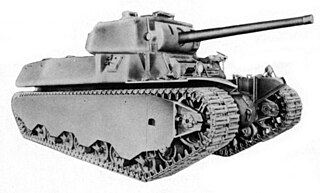
The Heavy Tank M6 was an American heavy tank designed during World War II. The tank was produced in small numbers and never saw combat.
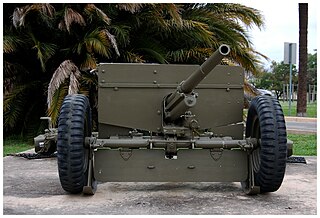
The 37 mm gun M3 is the first dedicated anti-tank gun fielded by United States forces in numbers. Introduced in 1940, it became the standard anti-tank gun of the U.S. infantry with its size enabling it to be pulled by a jeep. However, the continuing improvement of German tanks quickly rendered the 37 mm ineffective and, by 1943, it was being gradually replaced in the European and Mediterranean theaters by the more powerful British-developed 57 mm gun M1. In the Pacific, where the Japanese tank threat was less significant, the M3 remained in service until the end of the war, but some 57mm guns were issued.

The M46 Patton is an American medium tank designed to replace the M26 Pershing and M4 Sherman. It was one of the U.S Army's principal medium tanks of the early Cold War, with models in service from 1949 until the mid-1950s. It was not widely used by U.S. Cold War allies, being exported only to Belgium, and only in small numbers to train crews on the upcoming M47 Patton.
Tank development both evolved considerably from World War II and played a key role during the Cold War (1945–1990). The period pitted the nations of the Eastern Bloc and the North Atlantic Treaty Organization (NATO against each other.

The 3-inch gun M1918 was a United States 3-inch anti-aircraft gun that entered service in 1918 and served until it was largely superseded by the 3-inch anti-aircraft gun M3 in 1930, though the M1918 remained with some National Guard units until early in World War II. The M3 was subsequently replaced by the M1 90mm AA gun early in World War II, primarily during 1942. The M3 3" gun was later adapted for the anti-tank role, serving as the main armament of the M10 tank destroyer during World War II.

The 240 mm Howitzer Motor Carriage T92 was a self-propelled howitzer developed by the United States during World War II. The same mounting with the 8-inch Gun M1 was developed as the T93. Neither was built in significant numbers and the war ended before they could be used in combat.

The Medium Tank T20, Medium Tank T22 and Medium Tank T23 were prototype medium tanks, developed by the United States Army during World War II. They were designed as successors to the M4 Sherman. The standard main weapon for production versions of these designs was to be the 76 mm M1.

The 76 mm gun M1 was an American World War II–era tank gun developed by the U.S United States Ordnance Department in 1942 to supplement the 75 mm gun on the basic Medium tank M4. It was also used to arm the M18 Hellcat tank destroyer.
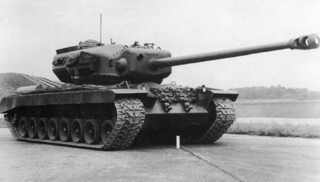
The Heavy Tank T29 was an American heavy tank project started in March 1944 to counter the appearance of the German Tiger II heavy tank. The T29 was not ready in time for the war in Europe, but it did provide post-war engineers with opportunities for applying engineering concepts to artillery and automotive components.

The United States has produced tanks since their inception in World War I, up until the present day. While there were several American experiments in tank design, the first American tanks to see service were copies of French light tanks and a joint heavy tank design with the United Kingdom.

This article deals with the history and development of American tanks from the end of World War II and during the Cold War.
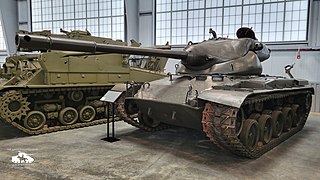
The T69 was a prototype American medium tank with an oscillating turret mounting a 90mm cannon with an eight-round drum autoloader. It held a crew of three. Developed on the basis of the T42 experimental medium tank in mid-50s, the vehicle never entered mass production.
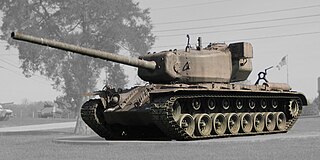
The 105mm L/65 T5 was an American rifled anti-tank gun developed in 1945. The T5E1 was the main armament for several American WWII heavy tanks designs, including the double-tracked T28 Super Heavy Tank and T29 Heavy Tank.


















